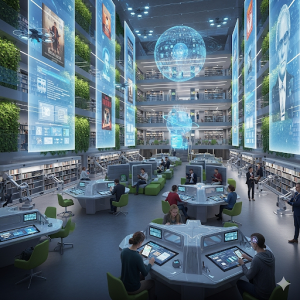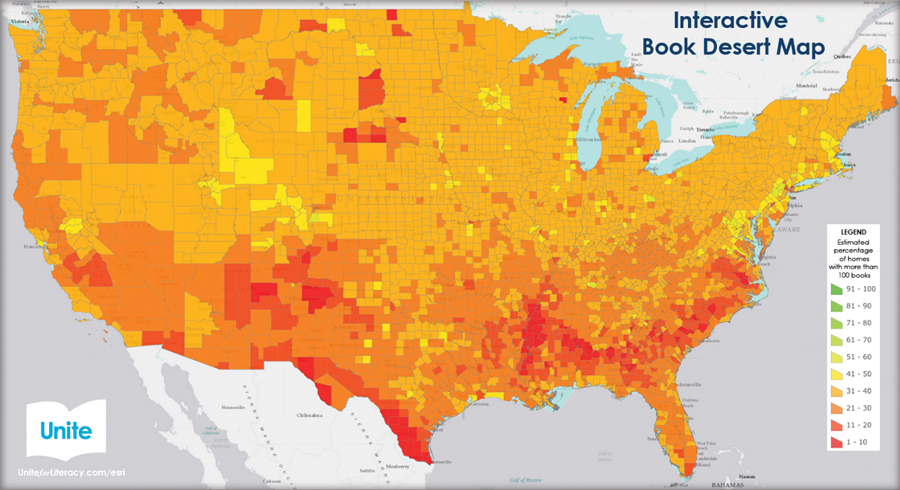“Hyperlinks are people, too”
-Michael Stephens in Hyperlinked Communities, n.d.
I think when most people hear the term “hyperlinked libraries”, they envision a futuristic library filled with cutting-edge technology like the one I created below using Gemini (Google, 2025).

Notice the drone in the top left corner and the robots in front of the shelves of books. However, as Michael Stephens points out in his lecture, “Hyperlinked Communities”, people are what make up a community as well as connections of related conversation (Stephens, n.d.). In this module, I loved exploring how libraries are meeting people where they are and are creating their own hyperlinked communities through truly unique and radical ideas. In “Heart of Librarianship”, Stephens (2016) described a library that turned their summer reading program upside down by opening it to the whole community instead of just children (Stephens, 2016, p. 42). This library also changed the focus of the reading program to a learning program. The library system I work for made this change two years ago, and the response from the public has been remarkable. Our participation numbers have increased, and people love the inclusivity of the program for their kids who are struggling learning to read, the caregivers with toddlers who are busy, busy, individuals who have disabilities, and the list goes on. People can still read if they want; however, acknowledging that all forms of learning are valuable is an example of a hyperlinked library community.

Hyperlinked libraries mean involving the community so they feel ownership of their library. Nutt (2024) from NC State University Libraries shared how they included members of their community through sharing pictures of the Hunt Library on Instagram (Nutt, 2024). The result was hundreds of gorgeous pictures featuring the library and the people who use it. Hyperlinked libraries acknowledge that the library needs to keep up with technology changes; however, it needs to address all technology needs (Williams & Muller, 2021). Thousands of patrons in the US are without broadband internet and rely on the library for high-speed internet and their computers. Hyperlinked libraries also acknowledge that books remain an integral part of the library. During the COVID-19 pandemic, BookTok became a hyperlinked community, elevating books, such as “The Seven Husbands of Evelyn Hugo,” to the bestseller list (Jensen, 2022). I have seen BookTok affect the books that are getting borrowed from my local library and witnessed the increase of young people in Barnes and Noble.

Another common misconception that I hear from people when I say I am working on an early literacy initiative is, “Can’t everyone afford books?” and “Doesn’t everyone have books?”. This couldn’t be farther from the truth. 32.4 million children in the US do not have access to books at home (Klinker, 2020). Read that number again. 32.4 million children. Access to books matters; it affects early literacy skills, which then affect success in school, and in turn, career opportunities. Diverse books matter (Klinker, 2020). Representation and inclusion affect self-esteem, confidence, and more. Many communities are without easy access to a public library. Some public libraries are trying to bridge this gap through hold lockers, similar to an Amazon package locker, where people can pick up holds and check out select items (Warner, 2024). My local library added a hold locker right outside the library so patrons can pick up their holds at any time. This is people-centered librarianship and, at its core, a hyperlinked library. It is evolving the library’s materials and resources to meet people where they are and to support their needs.
References
Jensen, K. (2022, February 10). As seen on #booktok: Inspiring young readers, tiktok is a boon for books. School Library Journal. https://www.slj.com/story/as-seen-on-booktok-inspiring-young-readers-tiktok-is-a-boon-for-books-libraries
Klinker, J. (2020, July 24). The healing power of books: Using reading to address social and emotional needs. GALE Blog. https://blog.gale.com/the-healing-power-of-books/
Nutt, M. (2024). My #huntlibrary. NC State University Libraries. https://www.lib.ncsu.edu/projects/my-huntlibrary
School Library Journal. (2019, February 1). Addressing book deserts: editorial. https://www.slj.com/story/addressing-book-deserts-editorial
Stephens, M. (n.d.). Hyperlinked libraries [recorded lecture]. Canvas. https://sjsu-ischool.hosted.panopto.com/Panopto/Pages/Viewer.aspx?id=3eacdb23-84fd-49e5-9975-aef3014b3ed2
Warner, L. (2024, January 17). Revolutionizing public libraries: Three ways that alternative service delivery strategies can meet the challenges of a booming population. https://medium.com/@lauracwarner/revolutionizing-public-libraries-ff7fed3d12c5
Williams, A., & Muller, C. (2021, March 17). Libraries are bridging the digital divide. Internet Society. https://www.internetsociety.org/blog/2021/03/libraries-are-bridging-the-digital-divide/
@missjennthelibrarian i’m going to focus in on the last section of this super interesting reflection. The book Desert concept is incredibly striking, and I don’t think I had seen much mention of this until recently. I actually forwarded it on to some of the librarians locally because of course I was looking at how the map was for Michigan. This is something to take very seriously I’m so glad you are thinking this way.
Thanks for reading and replying! Early literacy is something that I am very passionate about and so I try to incorporate it into my SJSU work as much as possible. I think this knowledge is not well-known, and libraries have a great opportunity to step into this space and meet a crucial need.